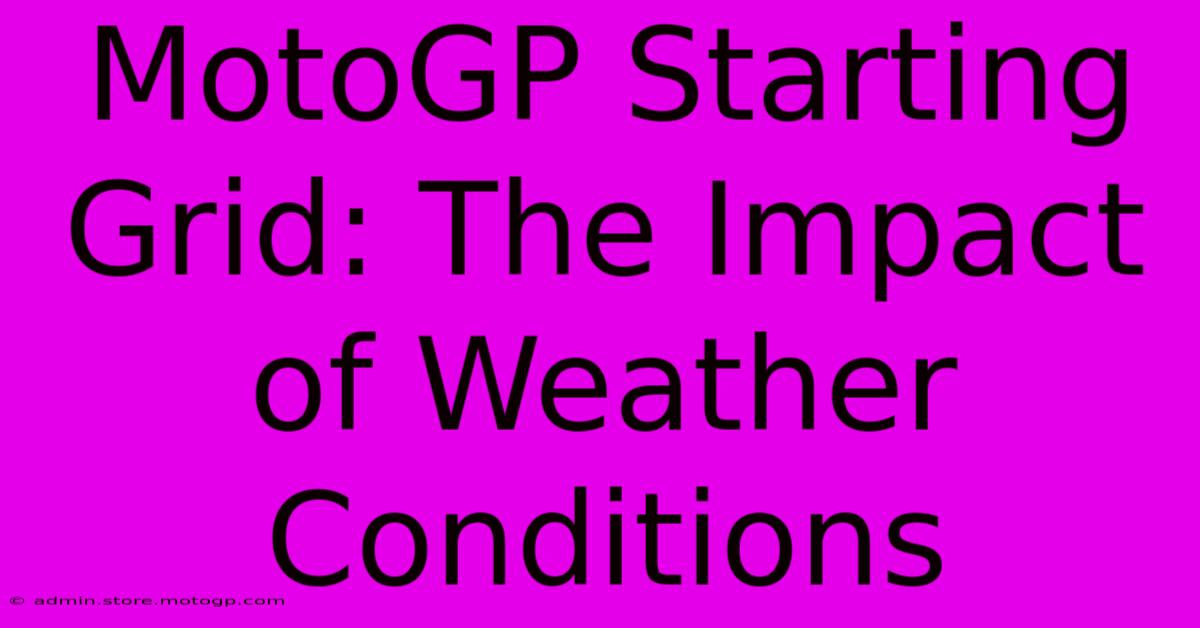MotoGP Starting Grid: The Impact Of Weather Conditions

Table of Contents
MotoGP Starting Grid: The Impact of Weather Conditions
The roar of the engines, the smell of burning rubber, the breathtaking speeds – MotoGP is a spectacle of skill and precision. But before the race even begins, a crucial factor can dramatically alter the outcome: the weather. The impact of weather conditions on the MotoGP starting grid is significant, influencing rider strategies, tire choices, and ultimately, the race itself.
Understanding the Starting Grid Formation
The MotoGP starting grid isn't randomly assigned. It's determined by qualifying sessions, where riders fight for the coveted pole position – the front of the grid. This prime spot offers a significant advantage, giving the rider a clear track ahead and potentially a crucial head start. However, weather can completely disrupt this carefully orchestrated order.
The Role of Qualifying
Qualifying sessions are crucial for determining the starting grid. A rider's performance directly impacts their grid position. Dry conditions usually allow riders to push their bikes to the limit, achieving the fastest lap times. But wet or unpredictable conditions level the playing field, making experience and tire management paramount.
How Weather Impacts the Starting Grid
Weather conditions can drastically change the starting grid dynamics. Let's explore the specific effects:
1. Wet Conditions: A Great Equalizer
Rain dramatically alters the game. Dry-weather specialists might struggle, while riders experienced in wet conditions excel. The starting grid in the rain often reflects this shift in expertise. Tire choices become critical – slick tires on a wet track are a recipe for disaster. Wet weather tires offer better grip, but their performance characteristics differ from dry tires, impacting acceleration, braking and cornering.
Key Considerations:
- Tire selection: Choosing the right wet-weather tire compound is crucial. Different compounds offer varying levels of grip depending on the track conditions.
- Riding style: Wet-weather riding requires a different approach, emphasizing smoother inputs and controlled movements.
- Track temperature: Even variations in track temperature can impact tire performance in wet conditions.
2. Mixed Conditions: A High-Stakes Gamble
Mixed conditions are arguably the most challenging. Parts of the track might be dry, while others are wet. Riders face the dilemma of choosing tires suitable for varying conditions across the track. A wrong choice could lead to a crash or significant time loss. The starting grid positions in mixed conditions become a bit of a lottery, often reflecting risk-taking strategies.
Key Considerations:
- Track analysis: Riders and their teams need to carefully analyze the track surface to identify wet and dry patches.
- Tire strategy: Choosing the right tire combination (front and rear) is critical to manage the mixed conditions.
- Race strategy: The starting grid position can significantly influence the initial racing strategy in mixed conditions.
3. Dry Conditions: Precision and Performance
Dry conditions showcase the purest form of MotoGP racing. Riders can push their machines to their limits, focusing on fine-tuning their setups and lap times. The starting grid tends to reflect a clear hierarchy of rider skill and machine performance. In dry conditions, the front row becomes even more coveted.
Key Considerations:
- Tire selection: Selecting the right dry tire compound is key for optimizing performance, grip and durability.
- Bike setup: Fine-tuning the bike's suspension and electronics is crucial for optimal performance.
- Track conditions: Even minor variations in track temperature or surface grip can influence lap times.
Conclusion: Weather's Unpredictable Influence
The impact of weather on the MotoGP starting grid is undeniable. It can shake up the established order, creating unexpected opportunities and challenges. While qualifying determines the initial grid, weather transforms it into a constantly evolving landscape. The ability to adapt to changing conditions and make smart strategic decisions becomes just as crucial as raw speed and skill. The thrill of MotoGP is enhanced by this element of uncertainty, reminding us that even the best-laid plans can be altered by the unpredictable forces of nature.

Thank you for visiting our website wich cover about MotoGP Starting Grid: The Impact Of Weather Conditions. We hope the information provided has been useful to you. Feel free to contact us if you have any questions or need further assistance. See you next time and dont miss to bookmark.
Featured Posts
-
Moto Gp Crash Today The Aftermath Unfolds
Feb 20, 2025
-
Free Moto Gp Live Stream The Race Is On
Feb 20, 2025
-
Moto 2 Bike Specs A Closer Look
Feb 20, 2025
-
How To Train Like The Best Moto Gp Riders
Feb 20, 2025
-
Queen Circuit Your American Adventure Begins
Feb 20, 2025
